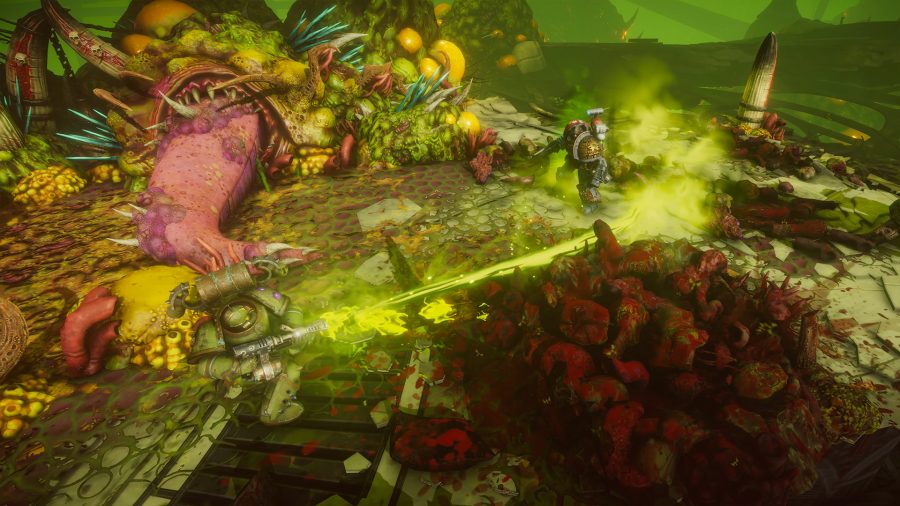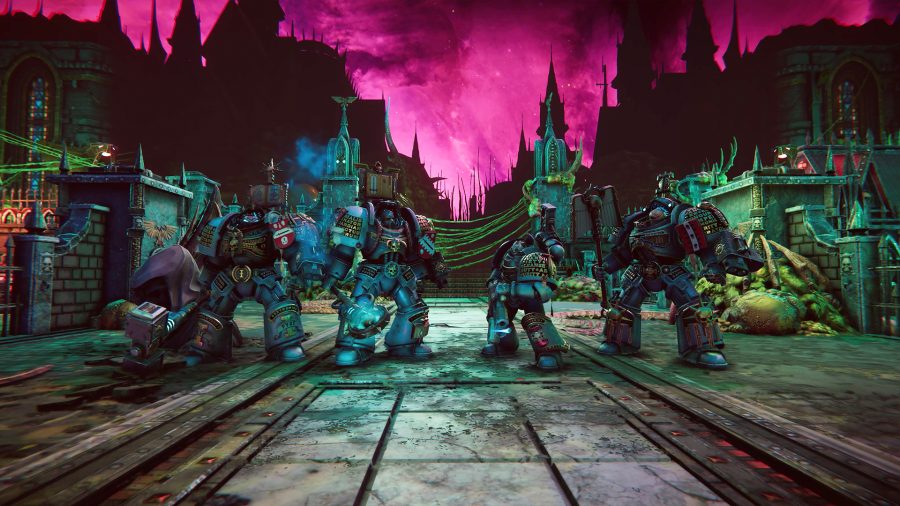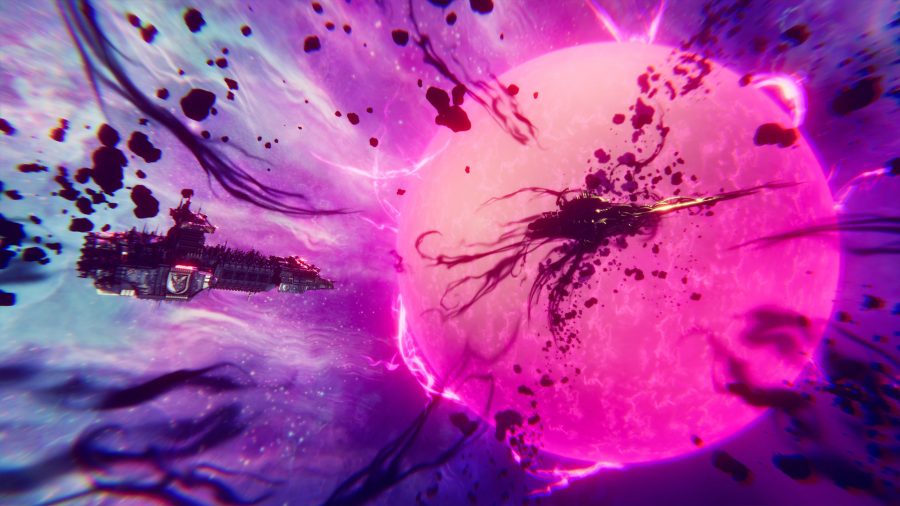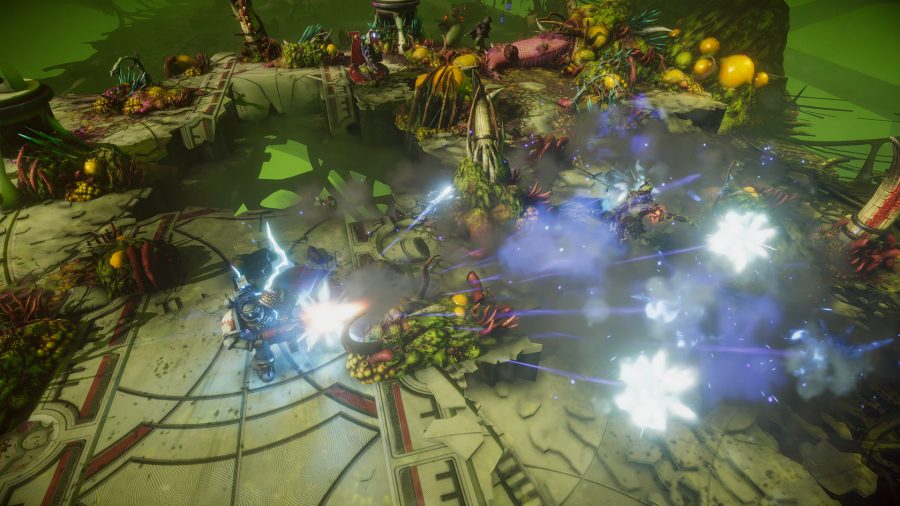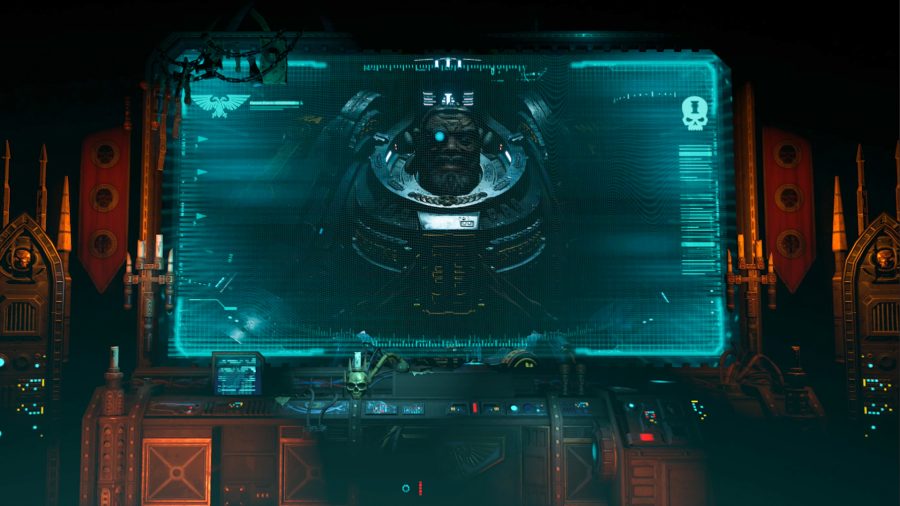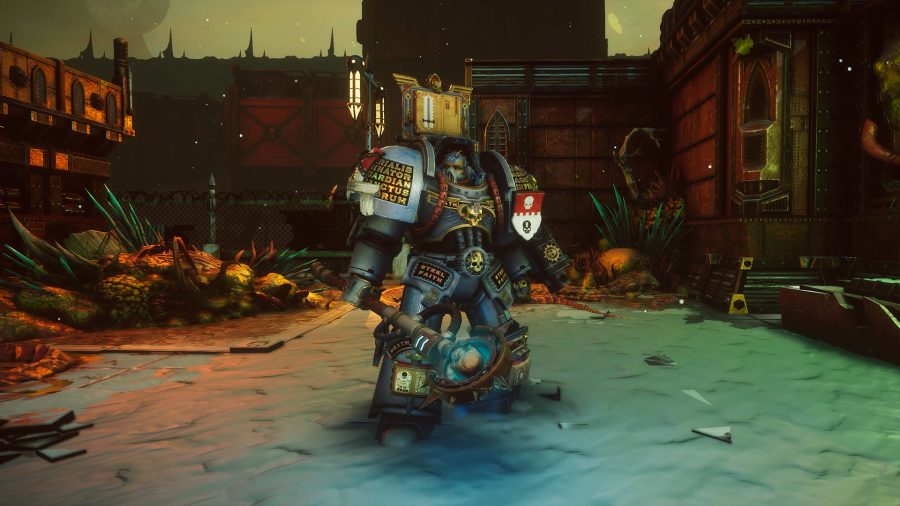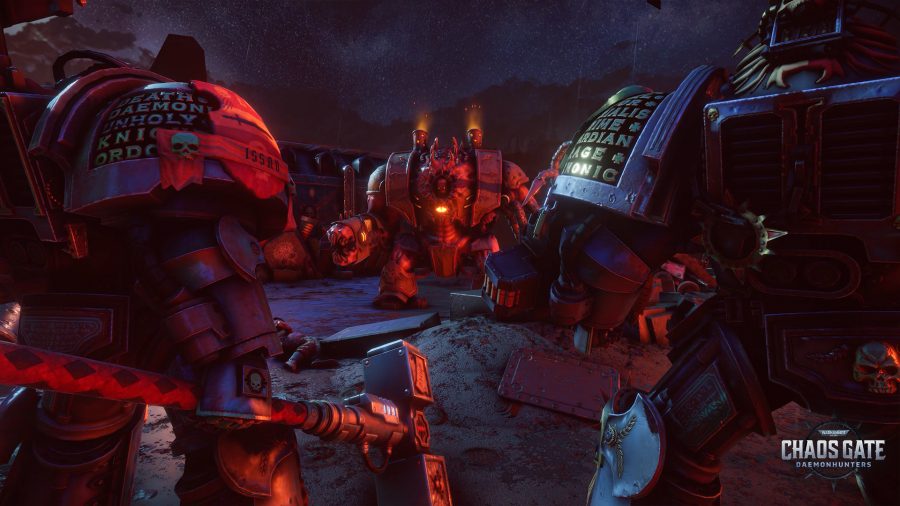Bubbling in a Nurglish cauldron somewhere in Winnipeg, Canada, at the HQ of little known game developer Complex Games, is Chaos Gate Daemonhunters: a highly promising, Games Workshop-licenced real time tactics PC game which – for our money – has all the hallmarks of a smashing Warhammer 40k game.
The friendly folks at Frontier – Daemonhunters’ publisher – recently invited Wargamer along to a press preview and Q&A, where we saw a goodly portion of recorded gameplay and picked the brains of Complex’s Creative Director, Noah Decter-Jackson, about what we can expect from the full game when it’s released on May 5, 2022.
Now, we at Wargamer are loyal servants of the Imperium (most of the time), so excited alert runes flashed up on our auspex screens when we heard, last June, that the Grey Knights were finally to star in their own videogame. Silver-armoured psychic Space Marines crafted from the Emperor’s own geneseed to be the perfect anti-Chaos daemon specialists, the Knights of Titan are bona fide badasses – and a squad-based real-time tactics game based on these esoteric elite warriors sounded like just what the Medicae ordered.
On the other hand, Warhammer 40k videogames are never a straightforward project, and their history is, alas, littered with misbegotten failures. Approaching a 40k game is a delicate business, both in terms of safely transmuting its tabletop experiences and acres of lore into videogame form, and in managing to carry its infamously pedantic, highly strung fanbase along for the ride [I’m allowed to say that, I’m one of them – Ed.]
Fortunately, all our auguries suggest Complex Games is onto a winner here. While much is still mired within the unreadable skeins of the future, the preview gave enough away about Chaos Gate Daemonhunters’ gameplay, story, and visuals to get us very interested indeed. Here are the three biggest lessons our order of prognosticars managed to glean.
It absolutely is XCOM 2 with Grey Knights – with a couple of twists
Since Firaxis’ excellent XCOM 2 came out in 2016 and taught literally everybody everywhere what turn-based squad tactics should look like, we’ve naturally seen a large number of games copy the core gameplay loop, structure, and overall experience to some extent.
It seems to say ’yes, I’m XCOM – but what else can I be as well?’
It’s an especially natural format for adaptations of Warhammer 40k – a turn-based tabletop wargame – to slip into, and XCOM’s rock-solid concept has inspired some of the better GW-licenced games, such as 2018’s Mechanicus (featuring the Adeptus Mechanicus and Necrons) and 2021’s Battlesector (pitting Blood Angel Space Marines against Tyranids).
What really strikes us about Daemonhunters is that, more than either of those titles, it doesn’t appear to pretend it’s not explicitly based on the XCOM formula. This game seems to have realised early on it that it was going to be XCOM with Grey Knights, and said to itself ‘OK, fine, that’s what I am; what else can I be as well?’.
For context: here’s our potted preview of the game for your consideration. In Chaos Gate Daemonhunters, you’ll manage, train, upgrade, equip, customise, and even name your own squad of individual Grey Knights. If any one of them dies, they’re gone for the whole campaign.
As Noah Decter-Jackson repeatedly told reporters during our preview, the story begins with your spaceship, the Baleful Edict, heavily damaged and barely functioning, and you must spend the rest of the game carefully meting out resources to repair and upgrade it, adding and improving the facilities within to care for and develop your Space Marines, as well as technical systems that can (among other boons) help the Edict zoom faster from mission to mission.
Nurgle’s faithful: Our guide to Warhammer 40k’s Death Guard
Missions are scattered across space, and you’ll expend time and resources flying between them – time itself being a vital resource, since the game’s overall story is a race to stamp out The Bloom (a plague created by the Chaos god Nurgle) before it engulfs the galaxy. The missions – both main story and side quests – mainly map onto a variety of tactical templates that have you seek and destroy stationary ‘Bloom Seeds’ hidden around the map, take down Chaos mini-bosses, or hurry to stop enemies from triggering some nasty event within a given time limit.
Much of the game takes place in a cosmic overworld campaign map where you choose missions, expending time and resources to fly from location to location. Momentum is maintained by means of a “doomsday meter” which tracks the extent of The Bloom’s expansion – tying you to the main plot, and forcing tough decisions between serving your prime directive, and pursuing juicy side quest rewards which might prove powerful later on.
Now, read those last few paragraphs again, but substitute in words like ‘aliens’ and ‘earth’ instead of ‘Bloom’ and ‘galaxy’… we’re sure you get the picture.
To us, though, this unapologetic commitment to building on an existing recipe that’s proven riotously popular, flexible, and endlessly replayable is far from disappointing. If anything, it’s refreshing – especially because, having used XCOM as its springboard, Daemonhunters is also striking out in several new and interesting directions that make it feel even more promising.
Chaos Gate ditches XCOM’s infamous reliance on RNG
First, it ditches XCOM’s infamous reliance on RNG (random number generation) to determine what happens in-game. Grey Knights, Decter-Jackson told us with notable gusto, know when they can or cannot hit a target (and they almost always can). When you mouseover your potential moves, surveying the resultant ranged and melee attack possibilities, the game shows you not a percentage chance to hit – but the amount of damage you’ll do when you do hit. It’s very fluff-appropriate, but it’s also a considerable shift in gameplay, that aims to conveys the power fantasy of being an elite Space Marine. We’ll wager it opens the door to some pretty brutal challenge levels, too.
The RNG only comes in to decide when you’ll score a Critical Strike in melee combat. Bag a crit, and the game’s ‘Precision Targeting’ system offers you various tempting options to screw up your enemy’s day – from disabling weapons to brutal execution moves. This looks like pure dopamine fuel, and we cannot wait to see more of it.
Codex Astartes: Our full guide to Warhammer 40k Space Marines
And, where XCOM 2 had paper-thin characters, relying almost entirely on the player imagining roles and stories for their carefully-nurtured troopers to maintain emotional investment, Daemonhunters shows every sign of offering much more developed narrative fare. Speaking of which…
It looks to have a meaty 40k story
Warhammer 40k storytelling isn’t for everyone, as any fan whose uninitiated partner has overheard them listening to a Black Library audiobook can attest. But, even for an audience of White Dwarf magazine subscribers, Complex could easily have Got It Wrong – most likely by half-assing the plot entirely, or by forcing lore details to take a back seat in service of broader accessibility. It seems clear, however, that it hasn’t.
There are 90 hours of in-engine cut-scenes – some interactive
According to Decter-Jackson, Daemonhunters will have “a ton” of voice acting, and over 90 hours of rendered in-game cut-scenes, including a large number that are “interactive” – meaning you’ll be faced with a field leadership decision, the Grey Knights in your squad will offer advice on how to proceed, and you’ll have to make the call. It’s a mechanic that could go either way – these could get formulaic and repetitive, or, if properly invested in, could make for thrilling, rewarding moments. Keep an eye on them.
Besides that, Complex Games has taken a leaf from Creative Assembly’s Tome of Fates, and invested a solid chunk of cash into some heavyweight Hollywood talent.

Just as Total War: Warhammer 3 enlisted The Hobbit star Richard Armitage to voice its villain, the Daemon Prince Be’Lakor, Daemonhunters has brought in beloved Gollum actor and general nerd-culture icon Andy Serkis to play Grand Master Vardan Kai, a critical NPC in the main story who both mentors and verbally berates the player in-game. A big-name actor can’t make a bad game good, of course – but such a serious investment of budget is a very good signal that storytelling won’t get short shrift here.
Be my fantasy: Read our Total War: Warhammer 3 review
That said, beyond the broad strokes of ‘plague bad, chaos bad, kill them all’ we know very little, as yet, of what the plot holds in store (although, in fairness to Complex, that might as well be a verbatim Imperial edict, for all the subtlety and balance you’ll get from mankind’s leaders in the 41st millennium). While we’re waiting, we’re pondering the arcane, because…
Psychic shenanigans are afoot
There have been quite a few Warhammer 40k videogames about Space Marines – not least the unsubtly titled, yet magnificent Warhammer 40k: Space Marine and its upcoming sequel – but, at least in my experience, none have properly leant into the mystic might of the Adeptus Astartes’ psykers, and its gameplay possibilities.
Psykers are awesome, and create some of 40k’s best stories
A primer: In Warhammer 40k, some humans (and armoured superhumans) have a gene which enables them to use their minds to manifest, for want of a better term, magical abilities by manipulating the Warp (a parallel dimension made of mortal beings’ emotions and inhabited by unimaginable terrors). These ‘psykers’ can do all manner of extraordinary things in combat – and their adventures and misadventures make up a solid slice of the most thrilling Warhammer 40k lore.
Most Space Marine chapters in the 41st millennium have relatively few of these psychic warriors among their number, calling them Librarians – but the top-secret order of the Grey Knights is different. Thanks to the unique genetic recipe from which they’re made, every single Grey Knight is a psyker – and their way of war is built upon this shared power.
In the tabletop game, every Grey Knights unit (rather than just a few specialists) can use offensive and defensive psychic powers – and Decter-Jackson confirms this is fully realised in Daemonhunters too, with your Knights getting access to various psyker abilities in different skill trees, depending on their class.
Brushing up: Here’s our guide to painting Warhammer models
Even more deliciously – and appropriately enough – your Nurgle-worshipping adversaries will often also have access to psychic abilities, calling on their foul patron’s diseased gifts to protect them or infect foes. They, too, get a different set of psyker abilities depending on the type of enemy, says Decter-Jackson – and some Knight classes have abilities specifically focused on ‘silencing’ enemy psykers in battle. It’s highly appetising stuff.

We could go on, as, even now, there are several other aspects of Warhammer 40k: Chaos Gate Daemonhunters which show real promise: the extensive environmental destruction and its apparent potential for damaging, killing, disabling, or re-routing foes, for example; the way the same mission’s map can change its shape and characteristics depending on how far the Bloom has progressed there; even the randomised ‘Warp Surges’ which can randomly trigger during a mission, spawning in extra enemies, upping your tactical challenge, and reshaping the map at a stroke.
For now, however, we will do as the prognosticars of Titan do – we will watch, we will wait, and we will prepare for the exact moment in time and space where we are needed. Also, we have some Paladins that need their shoulder pads painting…
Source: Wargamer




